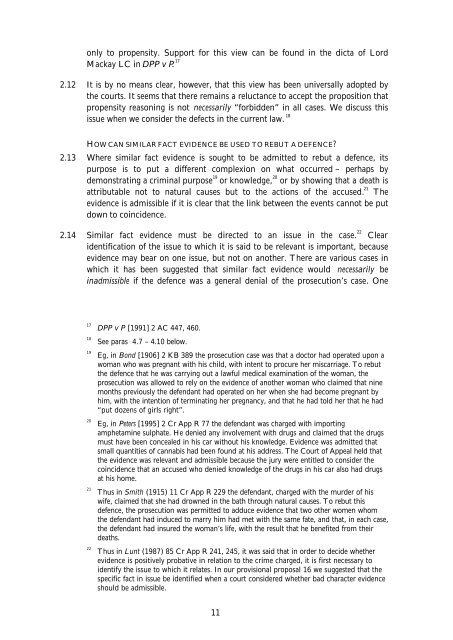Evidence of Bad Character in Criminal ... - Law Commission
Evidence of Bad Character in Criminal ... - Law Commission
Evidence of Bad Character in Criminal ... - Law Commission
You also want an ePaper? Increase the reach of your titles
YUMPU automatically turns print PDFs into web optimized ePapers that Google loves.
only to propensity. Support for this view can be found <strong>in</strong> the dicta <strong>of</strong> Lord<br />
Mackay LC <strong>in</strong> DPP v P. 17<br />
2.12 It is by no means clear, however, that this view has been universally adopted by<br />
the courts. It seems that there rema<strong>in</strong>s a reluctance to accept the proposition that<br />
propensity reason<strong>in</strong>g is not necessarily “forbidden” <strong>in</strong> all cases. We discuss this<br />
issue when we consider the defects <strong>in</strong> the current law. 18<br />
HOW CAN SIMILAR FACT EVIDENCE BE USED TO REBUT A DEFENCE?<br />
2.13 Where similar fact evidence is sought to be admitted to rebut a defence, its<br />
purpose is to put a different complexion on what occurred – perhaps by<br />
demonstrat<strong>in</strong>g a crim<strong>in</strong>al purpose 19 or knowledge, 20 or by show<strong>in</strong>g that a death is<br />
attributable not to natural causes but to the actions <strong>of</strong> the accused. 21 The<br />
evidence is admissible if it is clear that the l<strong>in</strong>k between the events cannot be put<br />
down to co<strong>in</strong>cidence.<br />
2.14 Similar fact evidence must be directed to an issue <strong>in</strong> the case. 22 Clear<br />
identification <strong>of</strong> the issue to which it is said to be relevant is important, because<br />
evidence may bear on one issue, but not on another. There are various cases <strong>in</strong><br />
which it has been suggested that similar fact evidence would necessarily be<br />
<strong>in</strong>admissible if the defence was a general denial <strong>of</strong> the prosecution’s case. One<br />
17 DPP v P [1991] 2 AC 447, 460.<br />
18 See paras 4.7 – 4.10 below.<br />
19 Eg, <strong>in</strong> Bond [1906] 2 KB 389 the prosecution case was that a doctor had operated upon a<br />
woman who was pregnant with his child, with <strong>in</strong>tent to procure her miscarriage. To rebut<br />
the defence that he was carry<strong>in</strong>g out a lawful medical exam<strong>in</strong>ation <strong>of</strong> the woman, the<br />
prosecution was allowed to rely on the evidence <strong>of</strong> another woman who claimed that n<strong>in</strong>e<br />
months previously the defendant had operated on her when she had become pregnant by<br />
him, with the <strong>in</strong>tention <strong>of</strong> term<strong>in</strong>at<strong>in</strong>g her pregnancy, and that he had told her that he had<br />
“put dozens <strong>of</strong> girls right”.<br />
20 Eg, <strong>in</strong> Peters [1995] 2 Cr App R 77 the defendant was charged with import<strong>in</strong>g<br />
amphetam<strong>in</strong>e sulphate. He denied any <strong>in</strong>volvement with drugs and claimed that the drugs<br />
must have been concealed <strong>in</strong> his car without his knowledge. <strong>Evidence</strong> was admitted that<br />
small quantities <strong>of</strong> cannabis had been found at his address. The Court <strong>of</strong> Appeal held that<br />
the evidence was relevant and admissible because the jury were entitled to consider the<br />
co<strong>in</strong>cidence that an accused who denied knowledge <strong>of</strong> the drugs <strong>in</strong> his car also had drugs<br />
at his home.<br />
21 Thus <strong>in</strong> Smith (1915) 11 Cr App R 229 the defendant, charged with the murder <strong>of</strong> his<br />
wife, claimed that she had drowned <strong>in</strong> the bath through natural causes. To rebut this<br />
defence, the prosecution was permitted to adduce evidence that two other women whom<br />
the defendant had <strong>in</strong>duced to marry him had met with the same fate, and that, <strong>in</strong> each case,<br />
the defendant had <strong>in</strong>sured the woman’s life, with the result that he benefited from their<br />
deaths.<br />
22 Thus <strong>in</strong> Lunt (1987) 85 Cr App R 241, 245, it was said that <strong>in</strong> order to decide whether<br />
evidence is positively probative <strong>in</strong> relation to the crime charged, it is first necessary to<br />
identify the issue to which it relates. In our provisional proposal 16 we suggested that the<br />
specific fact <strong>in</strong> issue be identified when a court considered whether bad character evidence<br />
should be admissible.<br />
11

















